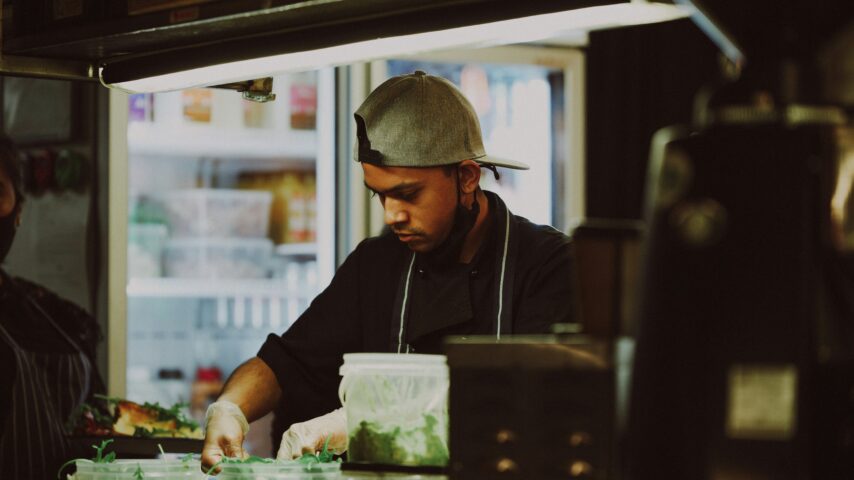Last week, Tenzo CEO, Christian Mouysset, joined Prask Sutton, CEO of Wi-5, and Zsuzsi Szentesi, Sales Engineer at Lightspeed for a Lightspeed-hosted webinar on the contactless restaurant experience. Focused on adapting to this ‘new normal’, Christian, Prask and Zsuzsi discuss the new restaurant playbook and how restaurateurs should be prioritising to stay top of mind for their customers.
Here, we break down exactly what these industry experts recommend.
Communication is key
Clear communication is absolutely essential nowadays. Your clarity is what gets people in the door and keeps them coming back again. Making sure all customers are aware of your Covid-19 game plan reassures them from the get go and takes away any unnecessary hesitation and anxiety about the experience. Customers feel like they can rely on you to behave appropriately, to have the right safety precautions in place.
Christian makes the point that potential customers are much more likely to choose where they eat ahead of time now, before they set out the door meaning you can no longer rely on foot traffic to wander in off the street. To capitalise on this, restaurants should make sure they are as visible as possible on social media and on Google. However, inspiration can strike from any platform, so don’t dismiss delivery aggregators such as Deliveroo or UberEats as potential catchments for dine-in customers as well.
Online advertising can also be a sure fire way to capture your ideal customer. Facebook, Google and especially Instagram ads can create more brand awareness particularly if you have an established social media presence where users can browse through images of your specialty dishes as well as any promotions in place. Christian also points out that you can geo-fence your ads to show up to users in a specific geography making your ads super targeted and avoiding unnecessary costs.
Finally, Christian emphasises the need for reviews. Personal experience has shown him that more and more people are looking at reviews than ever before, seeing what others have thought of a particular restaurant’s ambiance as well as the Covid measures put in place. If you capture your customers’ details during their visit, either through Wi-Fi connection, order & pay apps or QR codes on tables, use that information to ask for reviews. People are far more likely to click on a button in an email to leave five stars than they are to review by their own volition. And more reviews means more credibility.
Efficiency: more important than ever
Prask emphasises that operational efficiencies are more important than ever. Most restaurants are now operating at limited capacity and, therefore, your average transaction value and time per cover are stats you’ll want to keep a close eye on to be sure that you’re operating as optimally as possible.
You should also be thinking about how tech can take some of the pressure off your staff. At the end of the day, customer experience is most important and freeing up time for your staff to create the best experience possible will invariably work out well for you. You should be looking at where face-to-face interactions matter most (i.e. welcoming and seating) and where that interaction can be taken away. Prask gives taking payment as an example of where face-to-face is least important as sending the bill electronically won’t take away from the overall experience but will free up staff to focus on customers and provide that hospitality that makes going out to a restaurant such a special experience.
Christian also highlights that technology can replace your repetitive tasks on the operational side: automating reports or even forecasting demand. Using advanced forecasting algorithms can take the pressure off your GMs as forecasting sales in the current climate is no simple task. Employing an AI based forecasting tool will also help you maximise your revenues and minimise your costs by making sure you order in the right inventory and never over- or under-staff; a win-win.
Prask also makes the observation that thanks to a lot of innovation in the restaurant technology space, smaller independents now have access to the same systems that the big guys have and they can use the same information to make data-driven decisions much more cost-efficiently than in the past, allowing them to compete on the same level as the big chains.
Planning for the future
As we look to the future, the experts discuss how restaurateurs might handle another national or local lockdown and what they should do to prepare now. Christian emphasises the importance of delivery and click and collect as businesses with established systems in place were the ones to keep their doors open through the first lockdown. It therefore makes sense to expect these channels to continue to fare well if another lockdown comes into effect.
Additionally, from speaking to guests of the Tenzo podcast, In the soup, Christian has seen that despite being a few months ahead of us in recovery, restaurants in Asia haven’t seen a drop off in their delivery demand. In fact, it seems that now people have got a taste of getting deliveries of their favourite food and drinks, they’ve found that they still want it despite being able to go out. In fact, Jigger and Pony founder, Indra Kantono, started his cocktail delivery service as Singapore went into lockdown and saw it grow to the point where it now makes up 30% of his sales despite being reopened for business.
Christian also advises restaurateurs to look at the option of virtual brands. He encourages operators to consider brands that are close in style to what you already serve, but that encompass the whole day share, i.e. a more dinner-appropriate option if you usually serve the lunchtime rush. These virtual brands are getting more and more popular for good reason: delivery is no longer a luxury but a staple of living in a big town or city and customers now expect to be able to order whatever they want with the tap of a finger.
Prask also spotlights delivery as a potential lifeline for restaurants. However, he urges operators to focus on keeping your own customer data and not hand it over to delivery aggregators if you can help it. He says restaurants should use them as stepping stones for acquiring those customers for yourself, such as including flyers for your own app or website in their order to encourage them to order directly from you next time. And while having your own fleet of delivery drivers can be intimidating and cost-heavy, Prask recommends approaching other restaurants in your area to share the cost by starting a coop of delivery drivers where each restaurant chips in and gets use of the drivers.
Conclusion
It’s very clear that communication and efficiency are now the best tools in a restaurateur’s arsenal. Getting the message out loud and clear to potential customers that you are open, safe and abiding to the rules is the first step to getting them through the doors nowadays. And once they’ve made it inside, working as efficiently as possible is key with technology as a tool to do so. When it comes to planning to the future, investing in ways to maximise your revenues now will lessen the impact of another possible lockdown.
Don’t forget most of all though, that experience is key. Making the experience as enjoyable as possible for the customer, meaning that they can relax and not worry about their safety, will be the thing that gets people coming back time and time again.
A big thank you to Lightspeed for inviting Tenzo to take part in their webinar: you can watch the whole recording here. If you’d like advice on your tech stack and future-proofing your business, please contact Tenzo here.




